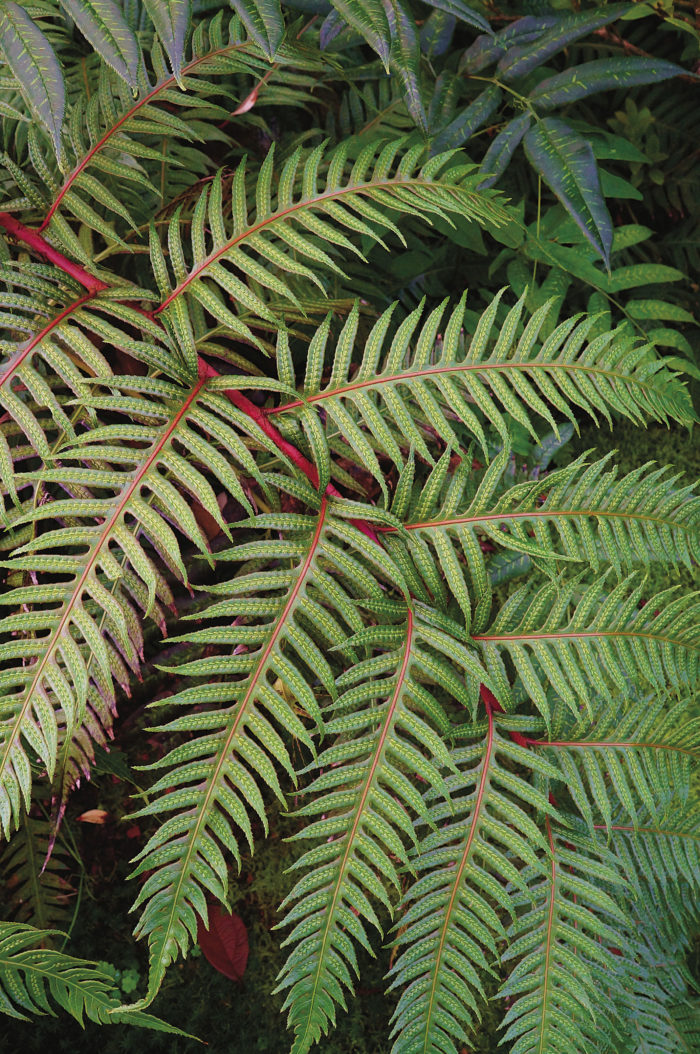
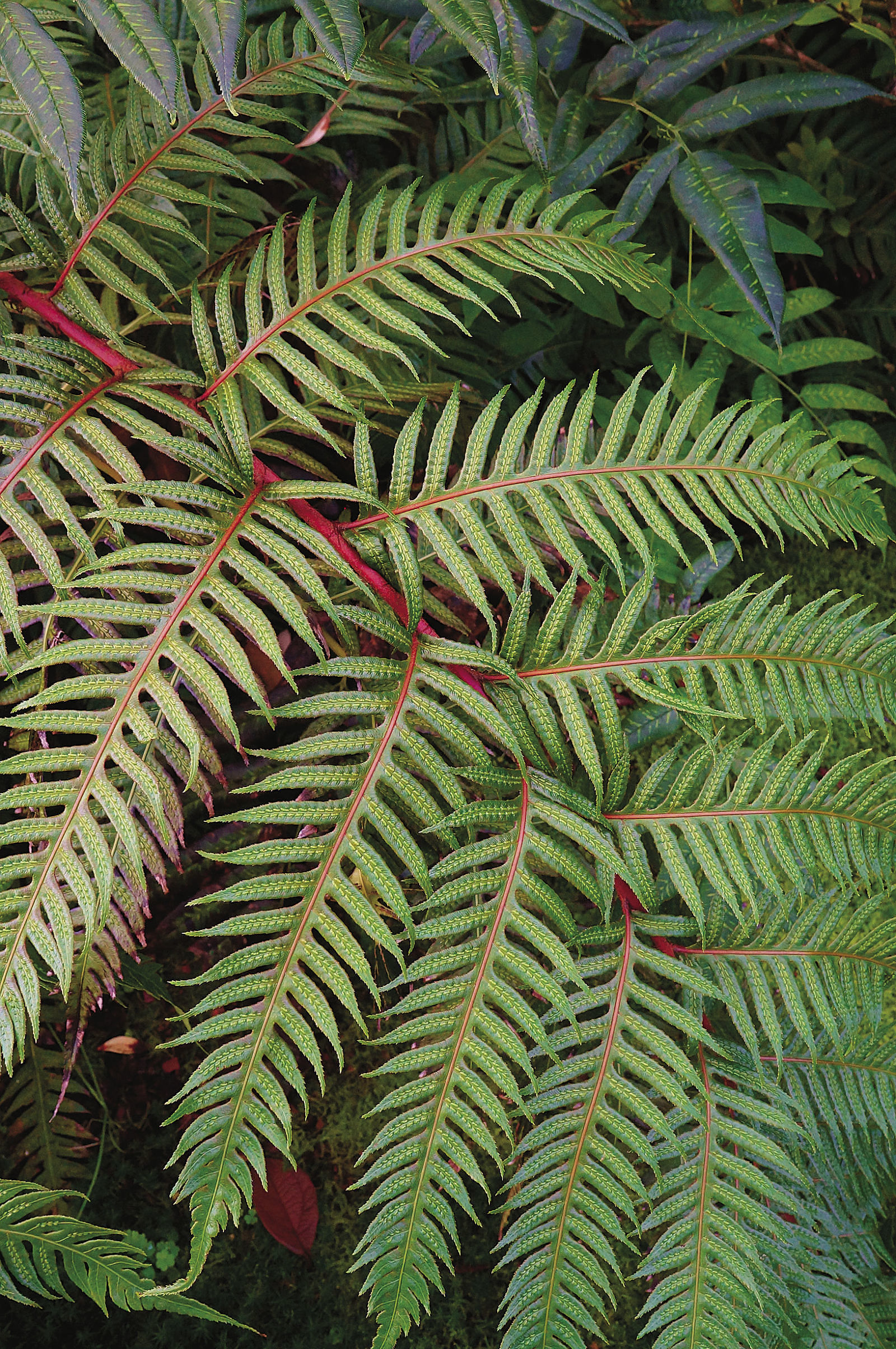
Jeweled chain fern is unique
Name: Woodwardia unigemmata
Zones: 8 to 10
Size: Stems and fronds up to 6 feet long, cascading
Conditions: Partial shade; moist soil
Jeweled chain fern certainly is a gem, with showy, arching fronds that emerge in brilliant shades of red and readily cascade over a wall or slope. Each frond grows up to 6 feet long and is tipped with a willing-to-root bulbil that the frond is attempting to bring down to accepting soil. These bulbils can be picked for propagating late in the season when they are plump. Place them on moist but not wet soil in a small pot, cover the pot with a clear plastic cup, put it under lights indoors, and wait for your reward. This species breaks the monotony of upright plants and is especially attractive in giving motion to a hillside.
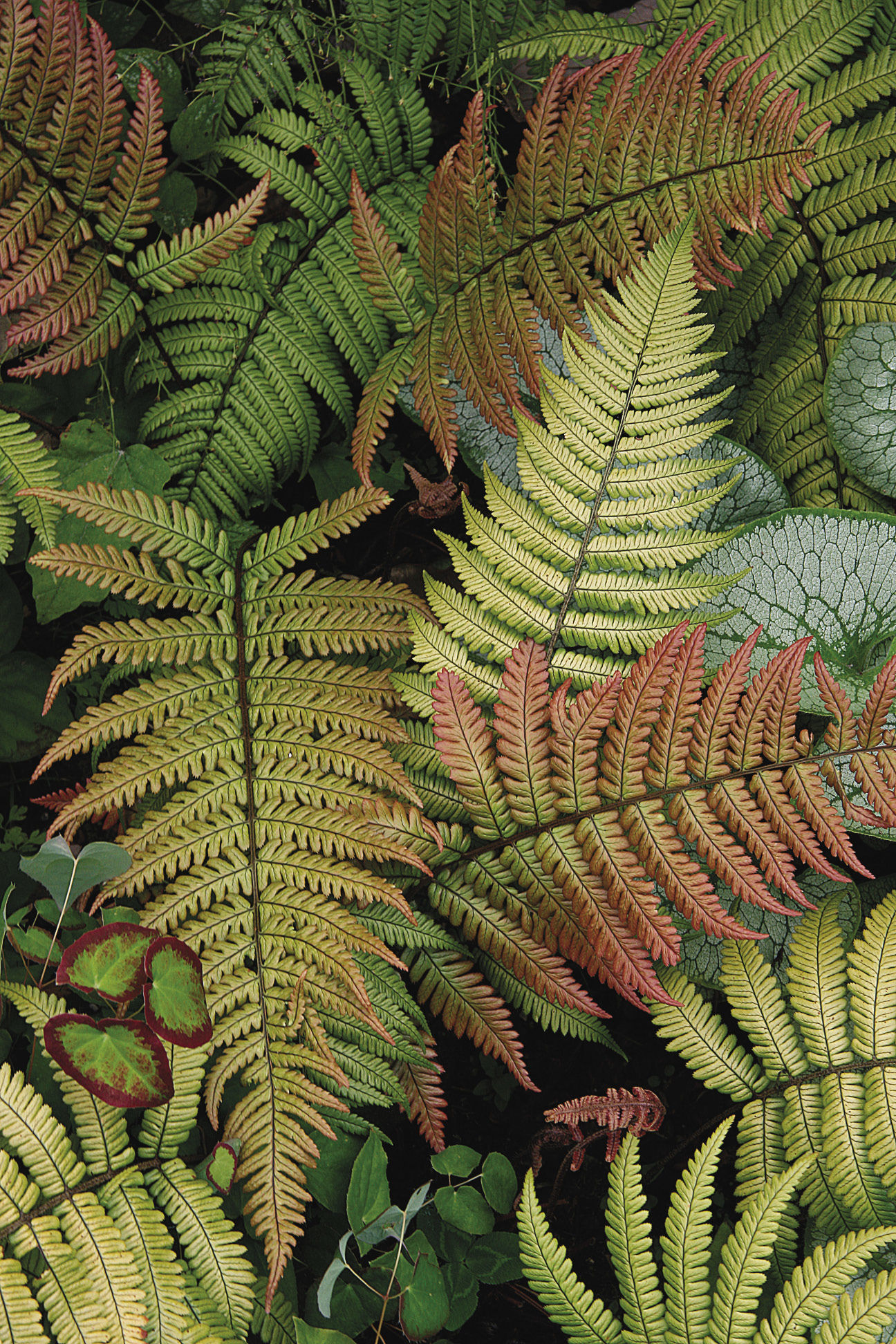
Sunset fern lives up to its name
Name: Dryopteris lepidopoda
Zones: 6 to 9
Size: 15 to 24 inches tall and 2 feet wide
Conditions: Light shade; humus-rich, moist but not wet soil
Common names vary in usefulness, but this moniker is a perfect choice for this stunning and adaptable species with its warmly colored pink/salmon/red/yellow, vase-shaped spring growth. Colorful new fronds continue to be produced throughout summer, giving a continuous show and glow to a lightly shaded area. With its reliably evergreen countenance, sunset fern makes an elegant edging to define a woodland path or a beckoning focal point to draw folks into a garden. It resembles the colorful Wallich’s wood fern (Dryopteris wallichiana, Zones 5–7) but is smaller in stature and a tad more cold tolerant. Relatively new in cultivation, it can be difficult to find on the market, but it is worth every effort, even for a nonfern enthusiast.
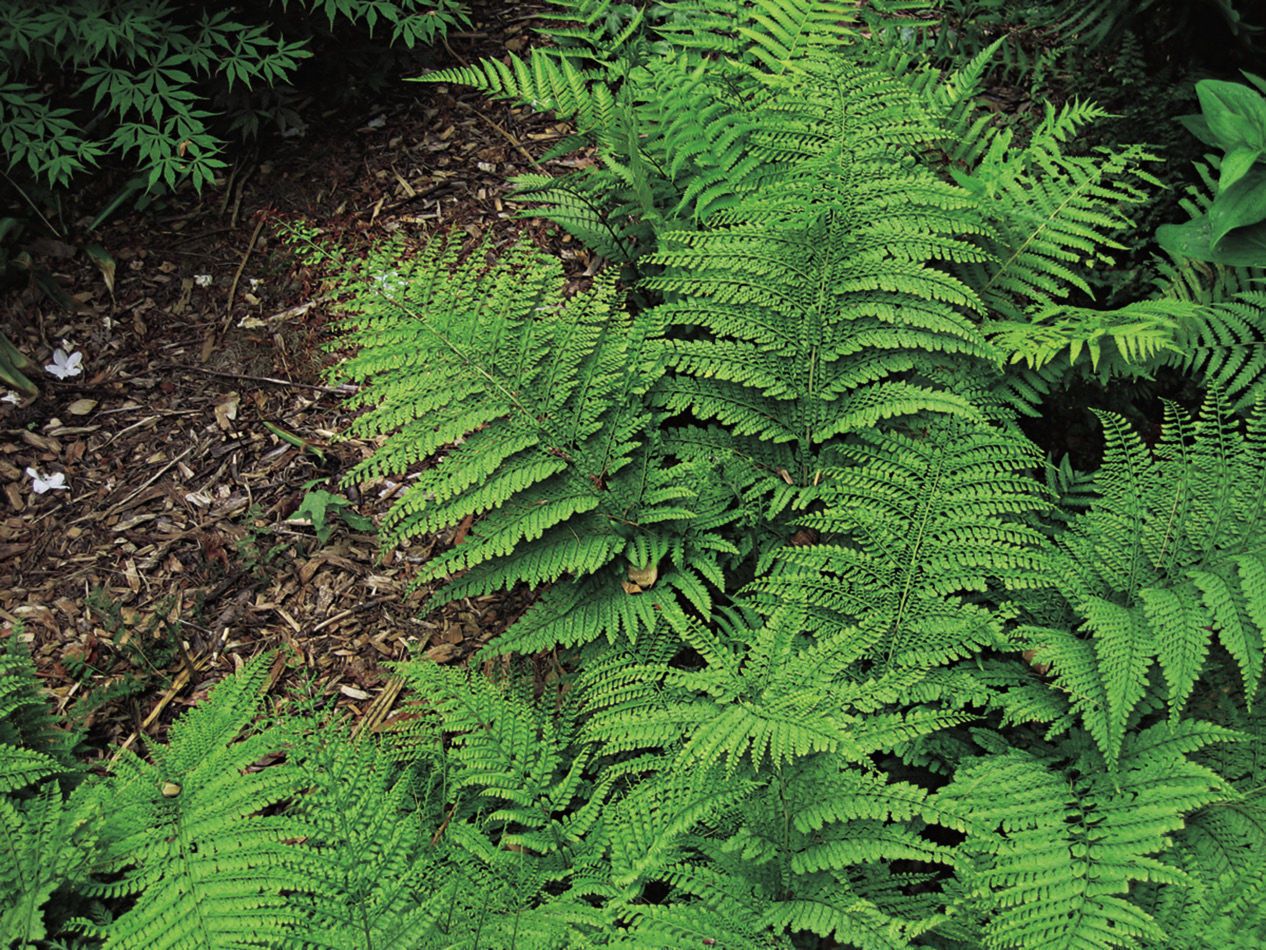
Upside-down fern forms a feathery vase
Name: Arachniodes standishii
Zones: 5 to 9
Size: 2 to 3 feet tall and 2 feet wide
Conditions: Partial to full shade; moist, loose, organic soil
Upside-down fern forms a sturdy, vase-shaped display of delicately patterned, lacy foliage in light shade. The prominent veins on top of the fronds give this fern its name. There are two types: The Korean version is somewhat larger than the Japanese version and is the most common one in cultivation. It makes an attractive contrast to heavier-looking evergreens.
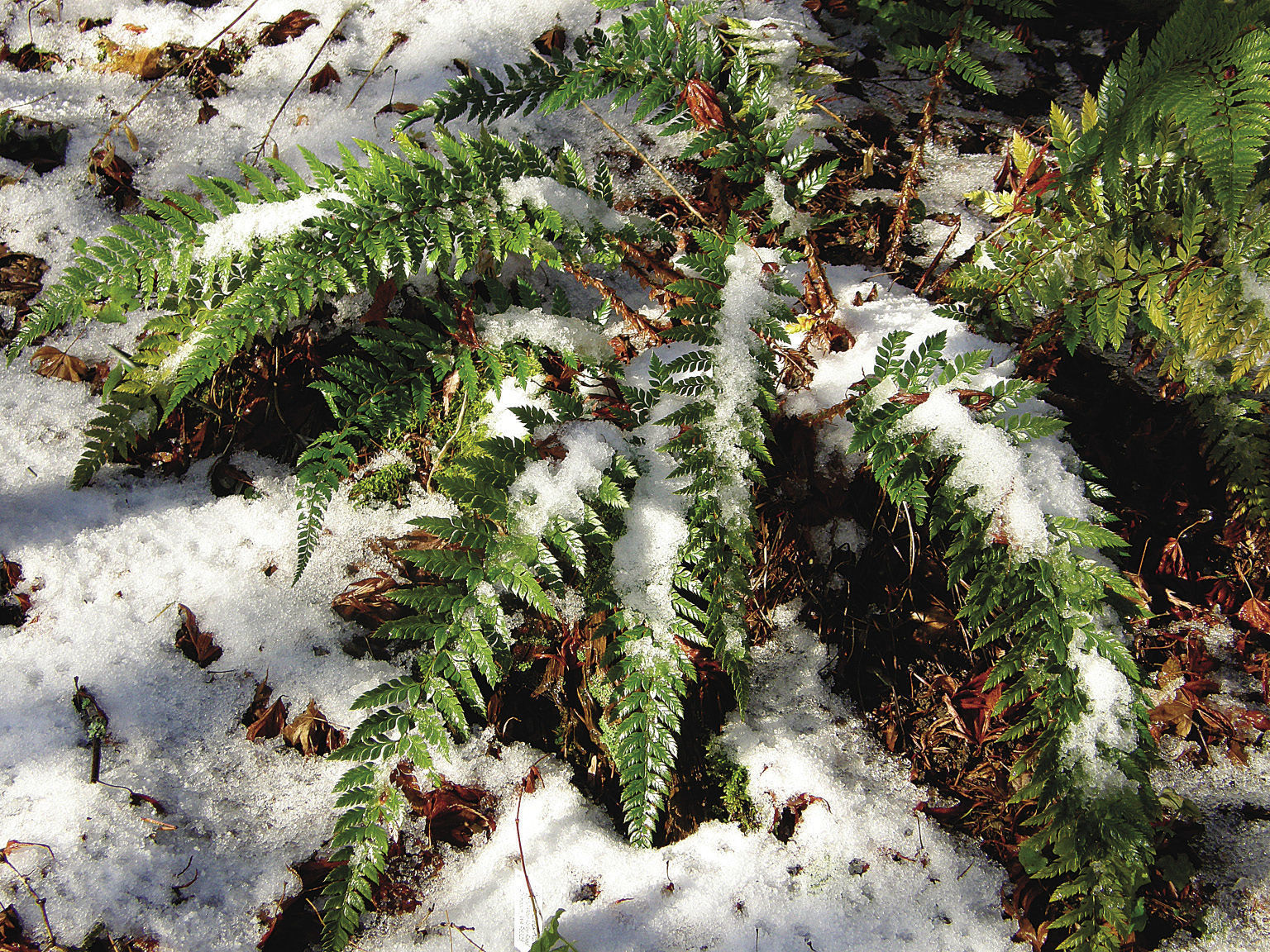
Asian saber fern stands up to snow
Name: Polystichum neolobatum
Zones: 5 to 8
Size: 18 to 30 inches tall and 2 feet wide
Conditions: Light to deep shade; moist soil
Not only is Asian saber fern evergreen, but it is also one of only a few ferns whose fronds will maintain their upright habit after being buried in a foot or so of snow. The narrow fronds are glossy and noticeably prickly to the touch. The new spring growth ignites interest with fiddlehead clusters that are thickly coated with ornamental russet scales. It will burn in the sun and does not like to dry out, but otherwise, this fern can be sited in almost any depth of shade.
They almost take care of themselves
While ferns are low maintenance, they aren’t completely without needs. As a fern grower, I get asked the same few questions over and over again:
When should I plant ferns?
Ferns can be planted whenever the soil is not frozen, but the best time is in early fall, giving them time to get established before the stress of winter. The essential condition is that ferns be kept moist while they acclimate to their new home and their roots get established. Even drought-tolerant types need water throughout their first summer.
Do they need to be fertilized?
Ferns should be planted in a loose mix of composted soil with good drainage. Given the proper setting, fertilizer is not necessary, although I allow fallen tree leaves to enrich the soil by remaining as mulch around the plants. And never add lime to the fern garden.
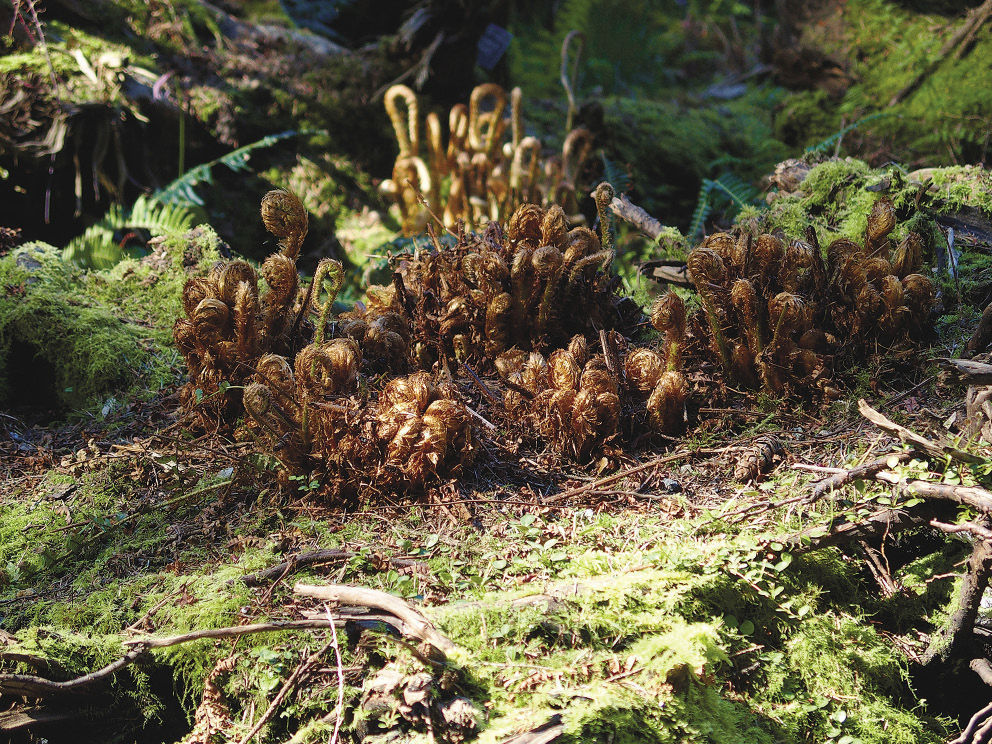
Can I divide them?
Ferns that creep or develop multiple crowns (photo, above) are candidates for division. The ideal time is in fall to give the transplants time to establish without the stress of heat and before the stress of cold. Using a sharp spade, carefully cut away the offspring. Replant divisions in good soil and partial shade, and keep them watered.
Should I cut back the fronds in spring?
Deciduous ferns are self-grooming and will lay their fronds down in fall. Evergreen fern fronds, however, will continue to produce food all winter, so it is best to leave them be until just prior to their new growth in spring. They can then be whacked off, but be careful not to cut any new fronds.
Do they have any pests?
Ferns, fortunately, have few problems with pests. Slugs and snails will find vulnerable new growth appetizing and should be discouraged with early applications of slug bait. Distribute the bait at a distance so as not to attract the predators to your delicacies. Aphids are rare but, again, are attracted to delicate new growth. They can be repelled with a gentle spray from your hose. Deer don’t usually bother ferns; rabbits, however, consider ferns and everything else in the garden their personal salad bars.
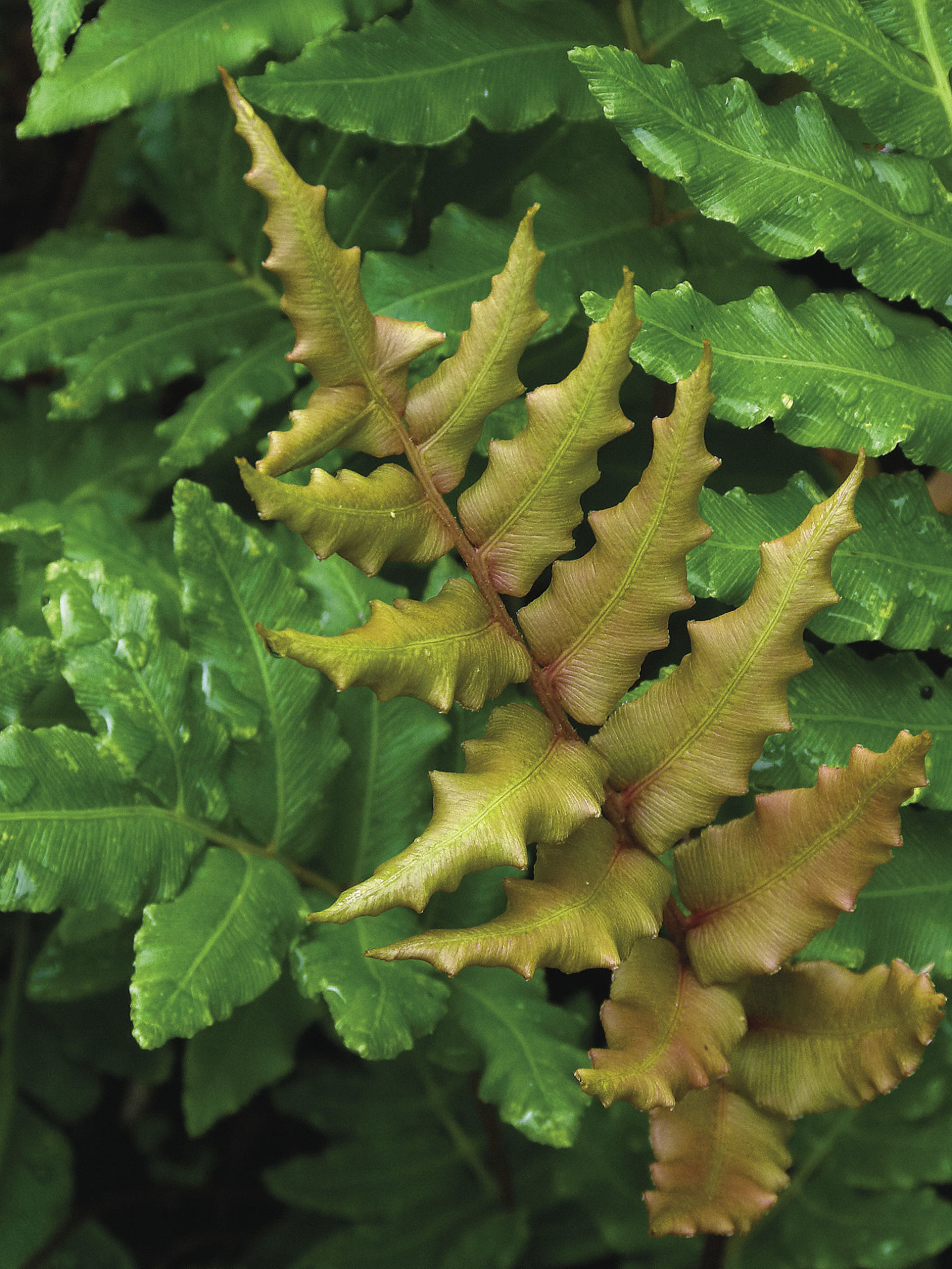
Chilean hard fern is an architectural wonder
Name: Blechnum chilense
Zones: 8 to 11
Size: 3 to 5 feet tall, spreading indefinitely
Conditions: Partial to deep shade; moist, well-drained soil
Chileans call this fern las costillas de la vaca, or ribs of the cow—an apt description. Chilean hard fern is superbly architectural. Its glowing red new growth (which is more prominent if the fern is not fertilized and not in nutrient-rich soils) turns into upward-reaching, statuesque stalks of fronds. It will tolerate slightly dry shade but will not be as exuberant. And with its creeping rhizomes, it can, indeed, be robust when happy (so much so that it is not possible to define a width). It will spread enthusiastically but is not aggressive or invasive.
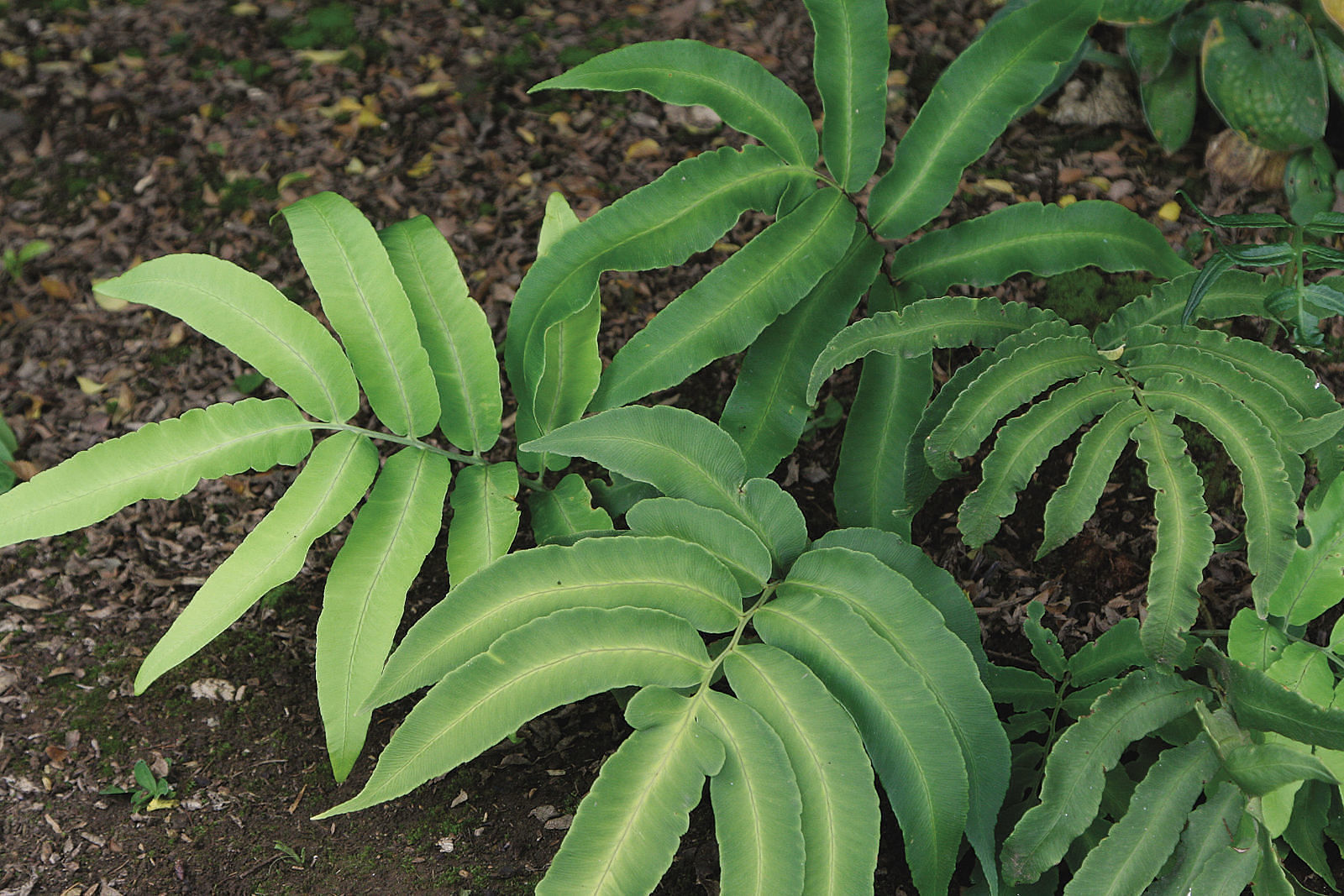
Siebold’s wood fern really is a fern
Name: Dryopteris sieboldii
Zones: 6 to 9
Size: 30 inches tall and wide
Conditions: Light shade; humus-rich, moist soil
Siebold’s wood fern is a plant with a distinguished and unique outline, prompting some visitors to ask, “Is that really a fern?” It’s a bold and highly ornamental conversation piece that does especially well when encouraged by warmth. In cooler areas, it expands rather late in the season and is somewhat frugal in producing its spectacular new foliage. The fronds look like long daggers and are a pastel blue-green—especially attractive when set among driftwood or mossy logs or when backed by a foliar foil that is light or very dark.
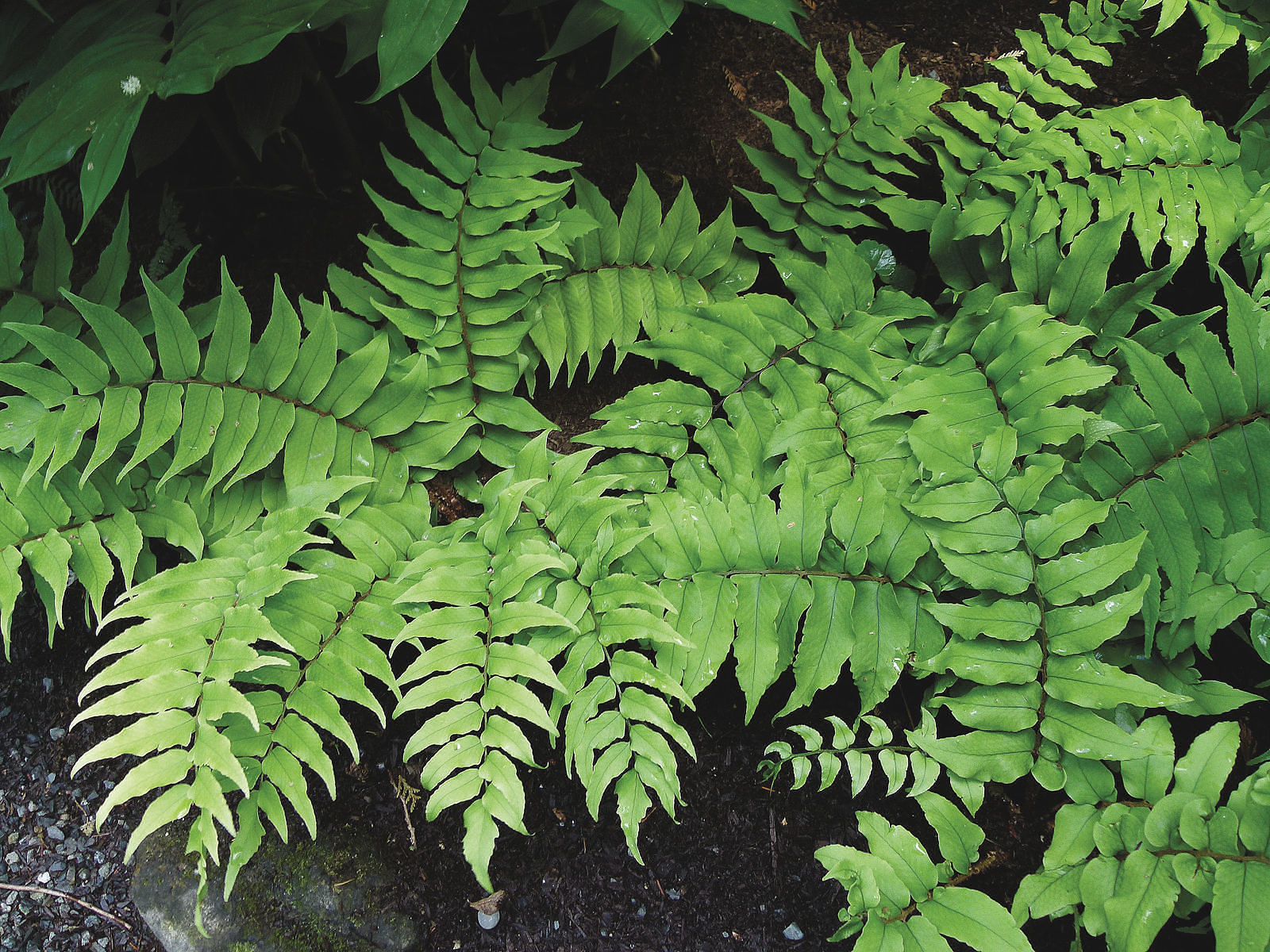
Fortune’s holly fern is as tough as it is bold
Name: Cyrtomium fortunei
Zones: 5 to 10
Size: 15 inches tall and 18 inches wide
Conditions: Partial to full shade; fertile, humus-rich, moist, well-drained soil
Fortune’s holly fern is the most cold tolerant of the holly ferns (Cyrtomium spp., Zones 5–11). The holly allusion refers to the unusual shape of the fern’s pinnae, which, with some imagination, can be said to resemble holly leaves. It does give the genus an appearance far different from the stereotypical lace-fronded fern and makes this species an excellent choice for providing an interesting contrast to the graceful appearance of more traditional ferns. This is an excellent choice for deep shade, where its pale green evergreen foliar rosettes bring a lightness to their surroundings. As with many ferns, it makes a nice foil for spring-blooming flowers. And when placed out of the sun, it also makes an easy-to-maintain indoor plant.
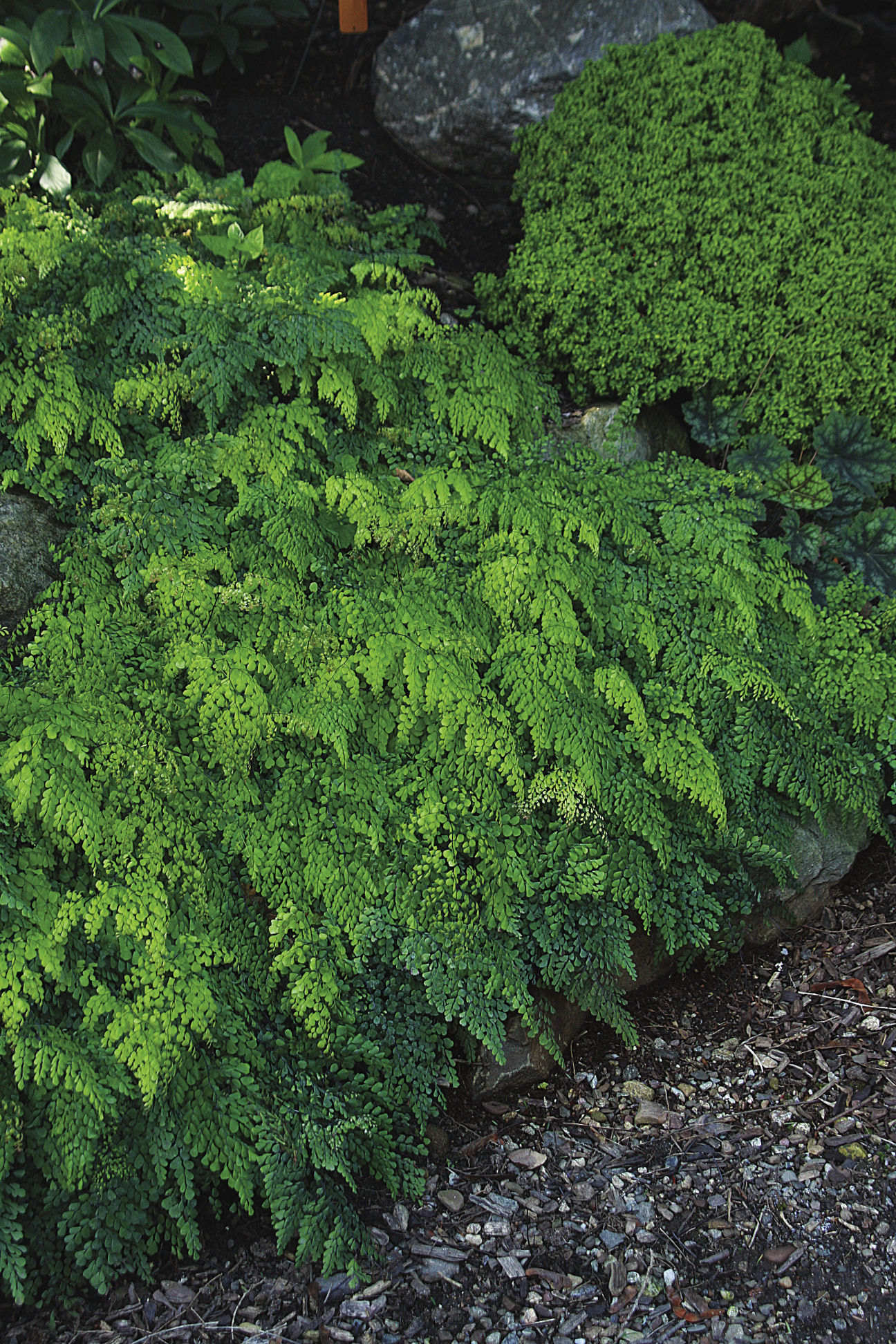
Himalayan maidenhair fern forms a frilly carpet
Name: Adiantum venustum
Zones: 5 (with protection) to 9
Size: 12 to 15 inches tall, creeping indefinitely
Conditions: Partial shade; moist, well-drained soil
Unlike our more familiar clump-forming native maidenhair ferns (Adiantum aleuticum and A. pedatum, Zones 3–8), this species will creep slowly but not aggressively to form an elegant, fine-textured, evergreen carpet. Despite its delicate appearance, Himalayan maidenhair fern is not fussy about soil and habitat, but as with most ferns, it flourishes in filtered shade and composted soil. In spring, new fronds appear first as pale rosy tendrils that unfurl slowly and aren’t usually affected by late frosts. While not necessary for the health of the plant, the old fronds can be cut back before spring to tidy up the plant. This fern can be divided in fall, but small pieces do not reestablish well, so take substantial divisions.
Sources
The following mail-order plant sellers offer the widest selection of the ferns featured:
Fancy Fronds Nursery, Gold Bar, Wash.; 360-793-1472; fancyfrondsnursery.com
Foliage Gardens, Bellevue, Wash.; 425-747-2998; foliagegardens.com
Plant Delights Nursery, Raleigh, N.C.; 919-772-4794; plantdelights.com
Sebright Gardens, Salem, Ore.; 503-463-9615; sebrightgardens.com
Sue Olsen is the owner of Foliage Gardens in Bellevue, Washington, and the author of Encyclopedia of Garden Ferns.
Photos, except where noted: courtesy of Sue Olsen; p. 44, millettephotomedia.com; p. 45, courtesy of Richie Steffen/Great Plant Picks; p. 46 (top), courtesy of Casa Flora; p. 48 (top), courtesy of Sebright Gardens; p. 49, Michelle Gervais
Fine Gardening Recommended Products

The Nature of Oaks: The Rich Ecology of Our Most Essential Native Trees
Fine Gardening receives a commission for items purchased through links on this site, including Amazon Associates and other affiliate advertising programs.

Planting in a Post-Wild World: Designing Plant Communities for Resilient Landscapes
Fine Gardening receives a commission for items purchased through links on this site, including Amazon Associates and other affiliate advertising programs.

ARS Telescoping Long Reach Pruner
Fine Gardening receives a commission for items purchased through links on this site, including Amazon Associates and other affiliate advertising programs.

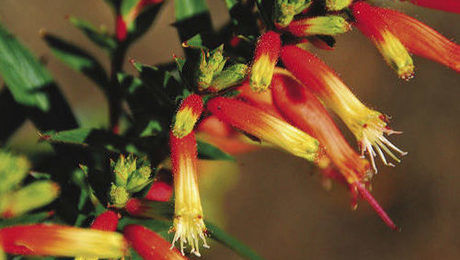


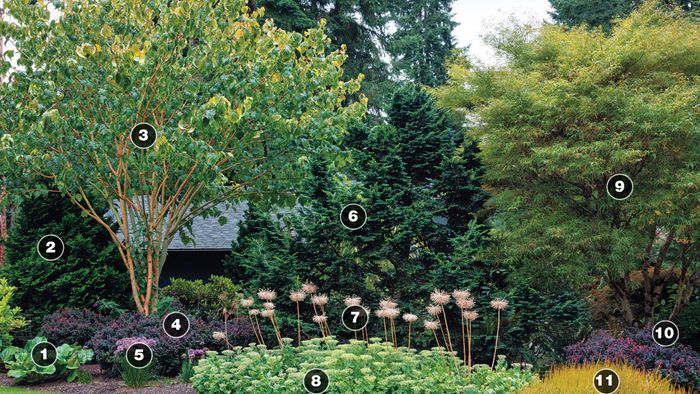












Comments
Log in or create an account to post a comment.
Sign up Log in